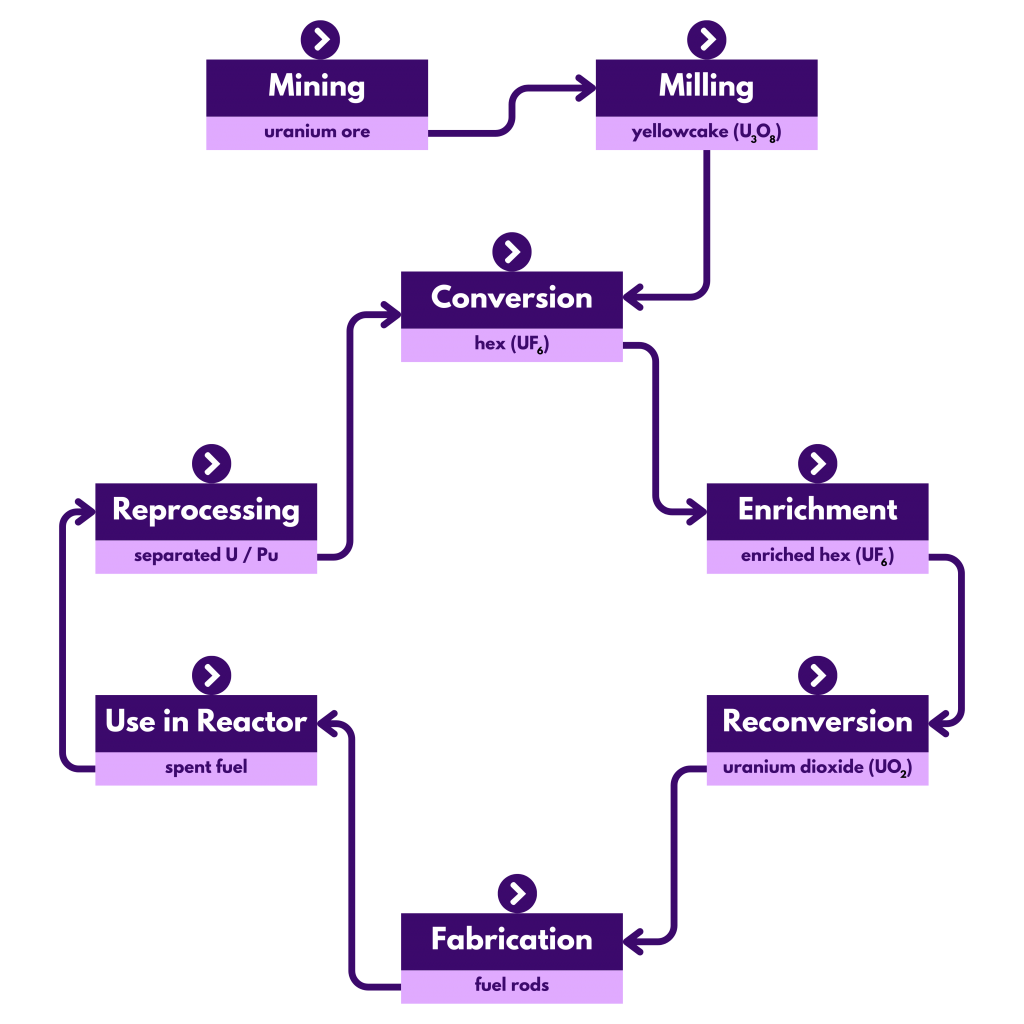Table of Contents
The Nuclear Fuel Cycle
The Nuclear Fuel Cycle is the sequence of processes a material must undergo to be used for nuclear power generation in nuclear power reactors. The cycle starts with initial extraction of the nuclear material from the ground and ends with either final disposal or reprocessing.
There are two types of nuclear fuel cycle: open and closed.
What is an open nuclear fuel cycle?
An Open Fuel Cycle is a linear sequence of processes, with fuel mined, used and eventually disposed – following a period of interim storage.
- Want to explore further? Click the explore buttons!
Advantages
Disadvantages
High Volumes of High Level Waste (HLW)
More Uranium Mining and Enrichment Needed
- Has the UK ever used an open nuclear fuel cycle?
What happens in the UK?
What happens in the UK?
What is a closed nuclear fuel cycle?
A Closed Fuel Cycle is a cyclical process where after fuel is mined and used, it is then reprocessed for reuse.
- Want to explore further? Click the explore buttons!
Advantages
Less Uranium Mining and Enrichment Needed
Reduced Volumes of High Level Waste (HLW)
Disadvantages
- Has the UK ever used a closed nuclear fuel cycle?
Magnox Reactors
The UK operated a closed fuel cycle for its now retired Magnox Reactors (first generation nuclear power stations). The Magnox fuel from these reactors was reprocessed at the Magnox Reprocessing plant at the Sellafield site in Cumbria. It was not possible to operate an open fuel cycle for Magnox fuel because the Magnox cladding on the fuel rods is vulnerable to corrosion, especially if stored in cooling ponds.
Advanced Gas-Cooled Reactors (AGRs)
The Advanced Gas-Cooled Reactors (AGRs), the UK’s second-generation nuclear power reactors, were previously run on a closed fuel cycle, with fuel reprocessed at the Thermal Oxide Reprocessing Plant (ThORP) in Sellafield until 2018. The UK has now adopted an open fuel cycle for spent AGR fuel. This is due to the affordability of mined uranium and concerns regarding the possibility of proliferation of plutonium.
Pressurised Water Reactors (PWRs)
The UK operates an open fuel cycle for its first Pressurised Water Reactor (PWR) at Sizewell B, and will operate an open fuel cycle for future PWRs (such as Hinkley Point C). Initially spent fuel is stored in spent fuel ponds on site, before being transferred to a dry fuel store, also on site.
Open vs Closed?
An open fuel cycle increases the amount of uranium mined from the ground, depleting this natural resource. As used fuel is not reprocessed, it must be disposed of – increasing the volume of high level waste. The UK does not currently have a solution in which this can be disposed of, but is looking to develop a Geological Disposal Facility (GDF).
In contrast, a closed fuel cycle decreases natural resource use. However, at the current time, reprocessing is more expensive than mining due to uranium being a relatively abundant natural resource. On a more positive note, reprocessing decreases the volume of waste products – only 3% of spent fuel is high level waste (the fission products) – the uranium and plutonium can be reused!
Adam Piatt
NSAN – Graduate Awareness in Nuclear (GAIN) Course (https://www.nsan.co.uk/page/GAINInductionTraining)
World Nuclear Association – Nuclear Fuel Cycle Overview (https://world-nuclear.org/information-library/nuclear-fuel-cycle/introduction/nuclear-fuel-cycle-overview.aspx)
Nuclear Engineering International – Sizewell Builds Dry Spent Nuclear Fuel Store (https://www.neimagazine.com/news/newssizewell-builds-dry-spent-nuclear-fuel-store/)
Peter Waggit / IAEA – Ranger Uranium Mine (https://www.flickr.com/photos/iaea_imagebank/4770418583/in/photostream/)
Wikimedia Commons – Chapelcross Nuclear Power Station, Scotland (https://commons.wikimedia.org/wiki/File:Chapelcross_Nuclear_Power_Station_2.jpg)
David Merrett – Heysham Nuclear Power Station (Heysham Nuclear Power Station | Lancashire, UK | David Merrett | Flickr)
Former Uranium Mine & Tailing Site, Peter Waggit / IAEA – Licence CC BY-SA 2.0 DEED
Yellowcake Barrel, Dean Calma / IAEA – Licence CC BY-SA 2.0 DEED
Barrels of Yellowcake, Dean Calma / IAEA – Licence CC BY-SA 2.0 DEED
Gas Centrifuges, US NRC – Licence CC BY 2.0 DEED
UO2 Powder, Chemolunatic – Licence CC BY-SA 4.0 DEED
Advanced Gas-cooled Reactor (AGR) fuel pin (about 1958-1982), Science Museum Group – Licence CC BY 4.0 DEED
Torness Nuclear Power Station (April 2016), Taras Young – Licence CC BY-SA 4.0 DEED
CLAB, Central Interim Storage Facility for Spent Nuclear Fuel (Oskarshamn, Sweden), Dean Calma / IAEA – Licence CC BY 2.0 DEED
ThORP at Sellafield, Raymond Knapman / Geograph – Licence CC BY-SA 2.0 DEED


